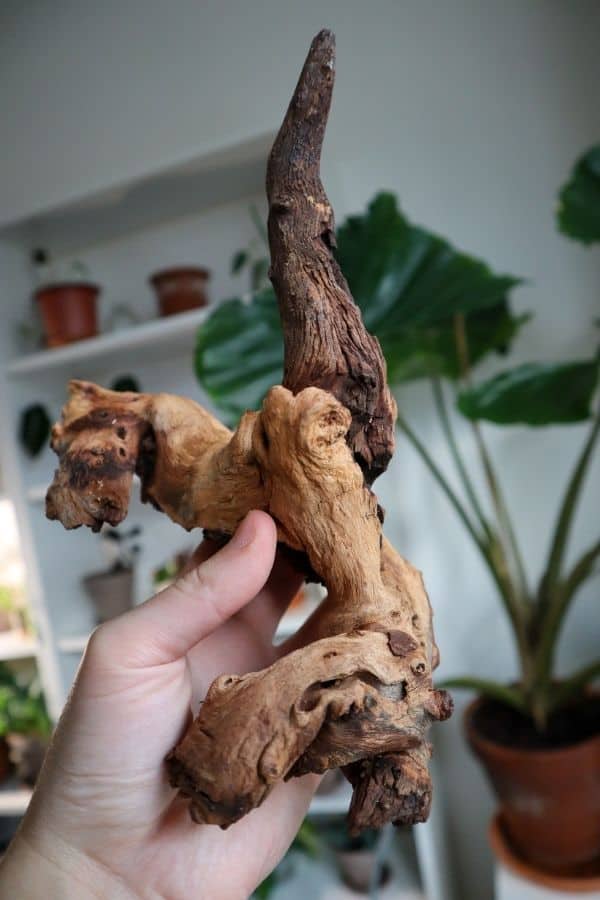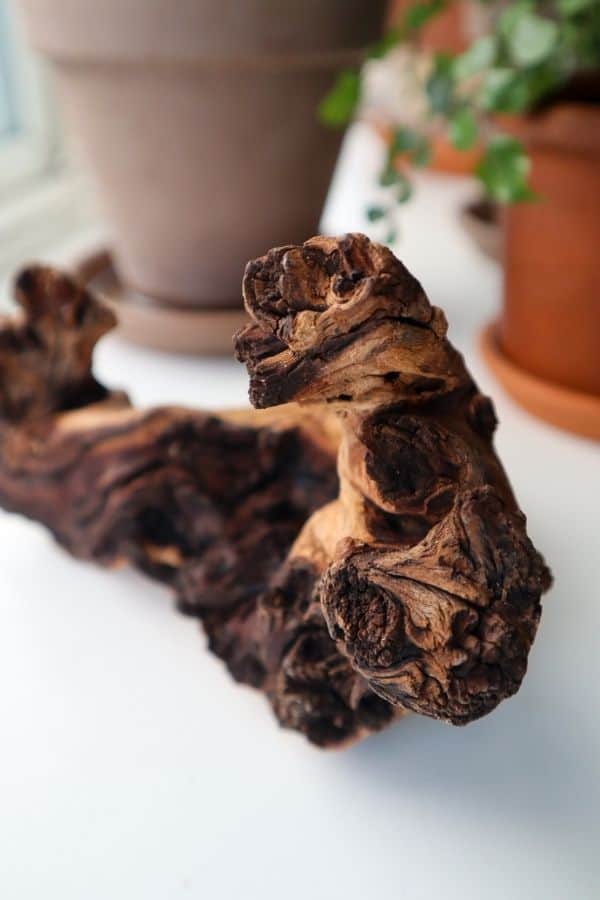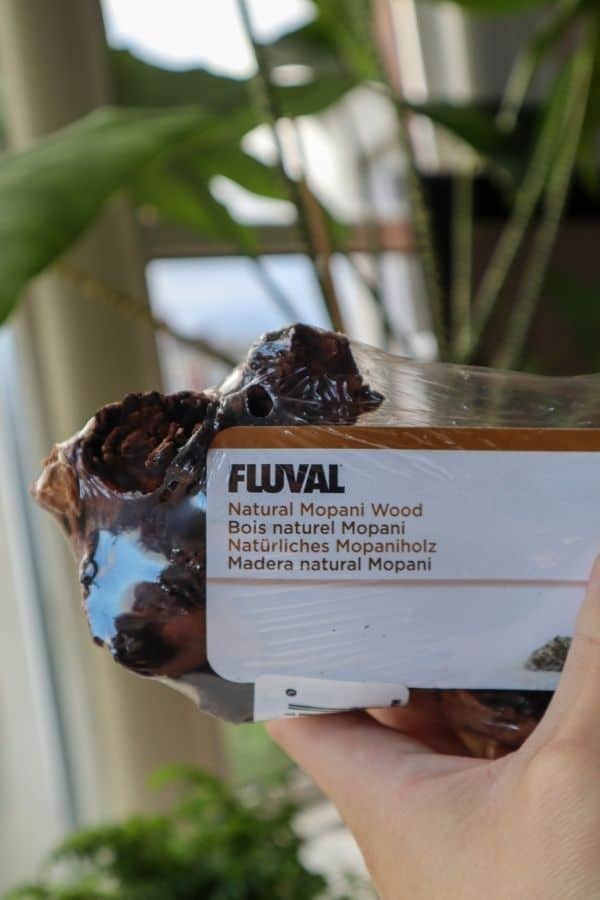As far as driftwood goes, Mopani Wood is arguably the leader of the pack.
Between its gnarled knots, windswept grain and sharp horns – this two-tone African hardwood looks like it’s straight out of the Lion King.
I believe it to be the most beautiful hardscape wood, and each piece is truly unique.
Find out how to use Mopani Wood in terrariums and vivariums of all kinds (yes, that includes aquariums) to elevate your landscapes to the next level.

Terrarium Tribe is reader-supported. When you purchase through links on our site, we may earn an affiliate commission (at no further cost to you). 💜
What is Mopani Wood?
Mopani Wood comes from the dried roots of the Mopane tree (Colophospermum mopane).
Native to South Africa, these trees can take the form of dense shrubs or colossal trees – which is probably what gives the hardwood such natural variation.
Honestly, the diversity of shape and texture is what makes Mopani Wood so special.
What I really love is the sense of flow in the wood. Each part of the natural grain leads into the next, drawing the eye with it and giving the impression of a singular, intentional piece.

Plus, that flow helps to channel water should you choose to make a water feature out of it.
Just saying…
Mopani Driftwood Benefits
1 | It’s Tough, Resilient, and It Won’t rot
Mopani is one of the toughest driftwoods out there.
I’d say Malaysian Driftwood is the only thing that comes close.
This works for us in that whatever environment you choose to use this wood, it’s going to stand the test of time.
You don’t need to worry about Mopani Wood rotting away underwater or in high humidity (Cholla Wood, I’m looking at you). It can last for years; it’s going nowhere.
2 | Quite Frankly, It’s Stunning
The distinctive tan and dark brown duo coloration lends itself well to desert scapes (like its natural environment), but it honestly fits into any natural scene.
Whether it’s a rainforest terrarium or a Congo river aquascape – you can’t go wrong with Mopani.
This one example branch I have here looks completely different from every angle.

The darker side tends to be made of the swirling gnarled texture, but the lighter tan side can be anything from a twisted branch to a chunky buttress. It all depends on the root.

3 | Nutritional and Antimicrobial Properties
Like several other types of driftwood, Mopani leaches compounds known as tannins into any moisture-rich environment that it’s placed into.
These tannins are known to have antimicrobial properties, and so when it comes to terrariums, they could help to keep any nasty pathogen growth in check.
Plus, they can be used as a food source by microfauna in bioactive terrariums and by shrimp and the like in aquariums.
Any Downsides of Mopani Wood?
To be fair, the tannins released by Mopani Wood can (and probably will) create a dark haze in aquarium water.
And, as far as driftwoods go, this is one of the worst for it.
Though it’s not to everyone’s taste (I mean aesthetically, don’t go drinking tank water), that haze is not actually bad for many aquarium species.
Firstly, it’s non-toxic and won’t harm your plants or animals. Secondly, it softens the water – and for the right species – it can help to promote an environment that’s more suitable.
This is absolutely not a problem in terrariums, but if you want crystal clear water in your aquarium, the wood may need boiling a lot first. More on that later.
How to Use Mopani Wood as Hardscape
As a Showstopper or Keystone Piece
The natural density and weight of Mopani make it a great centerpiece choice rather than a delicate accent piece.
Leave the accents to the lightweight Spiderwood and Manzanita wood.
Personally, I like to use Mopani Wood as the anchor point of a terrarium.
You can even glue together several chunks to create an impressive sprawling effect. Like the heart of a forest or a harsh alien landscape.
Yes, I like sci-fi and fantasy genres, okay…
As a Mount for Epiphytic Plants
The twisting nature of Mopani wood also presents lots of nooks and crevices to strategically “plant” epiphytes.
Miniature ferns (e.g., Bolbitis heteroclita “difformis”) and plants like Cryptocoryne and Bucephalandra will all work just as well in high-humidity environments as they would submerged underwater.
Some of these semi-aquatic species are very versatile.
You can glue them in or bind them with wire till they attach themselves. Or, sometimes, you can simply stuff carefully maneuver them into a tight spot.
Alternatively, the classic miniature terrarium vines like Ficus pumila or Peperomia prostrata would look lovely winding their way around the wood.
Where to Find Mopani Wood for Sale
It’s true that Mopani can be one of the more expensive varieties of driftwood on the market.
But to be fair, it’s to be expected from a wood that’s sourced from a tree that’s native only to some very specific regions in Africa.
I believe you get what you pay for here. A stunning piece of natural art that’s really going to go the distance in a container environment.
Normally, I’d recommend a specialist aquarium store here, but to be honest, Amazon seems to have the best range.
Or, more specifically, the terrarium/aquarium brands that sell on Amazon (i.e., Zoo Med and Fluval).

Mopani Wood Preparation
Regardless of where you’ve sourced your driftwood from, it’s usually a good idea to take the time to prepare it before adding it to any tank.
In a Terrarium / Vivarium
Here, preparation is as simple as giving it a good clean.
Even if it’s pre-washed, you can never be certain it hasn’t picked up something nefarious along the way, like bacteria or fungi.
Boiling in hot water is the usual preferred method.
It’s quick and easy and can help remove some of the tannins (if that’s what you want). Or, a scrub with a toothbrush and some soapy water tends to do the trick.
Mopani Wood Aquarium
Besides cleaning, the usual biggest concern for aquarium preparation is “sinking” it.
Often, the softer woods will float, so they need to soak in water first so they take in enough to sink. But, the natural weight of Mopani Wood means this is rarely necessary.
As mentioned above, the other reason is to remove some of those tannins ahead of time.
If you really want to circumvent the dark water effect from the tannins, then boiling the wood can help to extract them before you add the wood to the tank.
Though – after reading a variety of reports online – it sounds like it takes a lot to fully extract the tannins. People have tried multiple 2-3 hours rounds of boiling + water changes and still find it leaching.
Over to You
So, what do you think of the stunning natural material that is Mopani Wood?
I’m always keen to see how people make use of my favorite terrarium driftwood. Please feel free to share any of your work in the comments below!

Great article on mopani wood. I’ve been using them in my terrariums and they do very well. Didn’t know about the benefits of the tannins, so I learned something new. Thank you!
No worries! Glad to hear there’s a fellow connoisseur of Mopani Wood 🍷
I love the mopani wood I have it in my aquariums and my woodlice tanks. They are spectacular so I have some on my windowsill as a decorative feature. I’m about to try some mangrove wood in my aquarium for my zebra pleco.
loved your article! I’m resetting up a 55 gallon FW tank and needed some new driftwood. Ran across Mopani wood and it appealed to me so I bought it. So glad I did. Very attractive piece of wood. Very nice addition to my tank. Now I know even more about it thanks to you guys!
Thank you for sharing the information!! awesome!
GREAT PIECE OF INFO. Thank you wasn’t aware of the uses. I have a number of pieces on my plot.